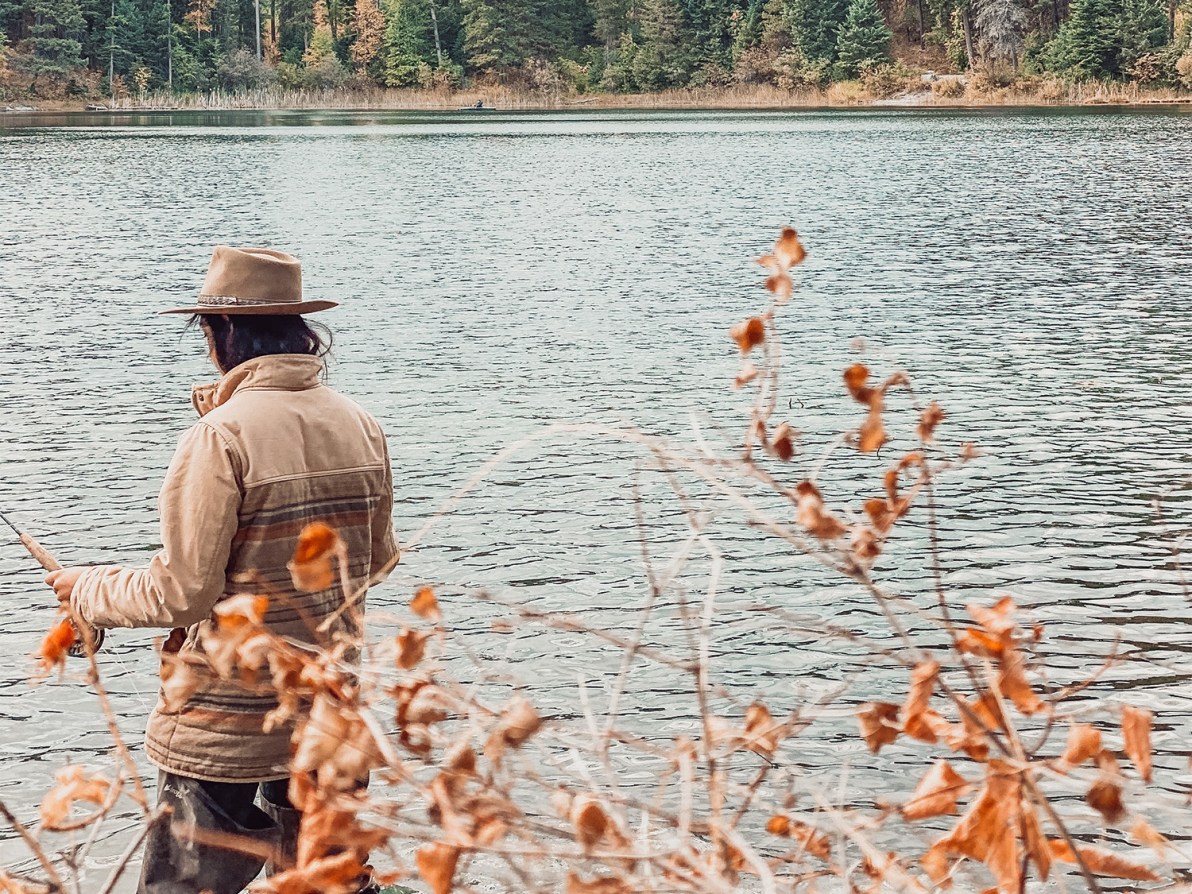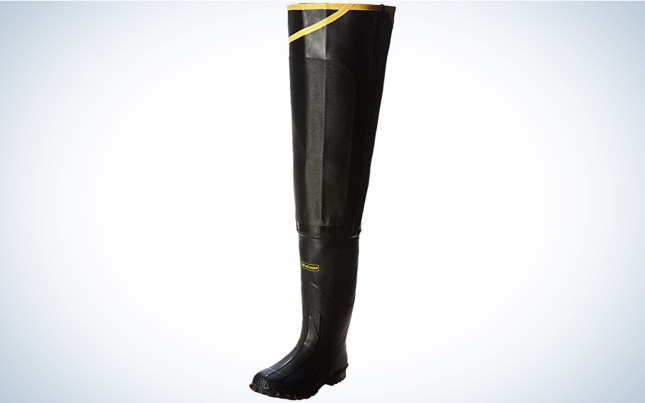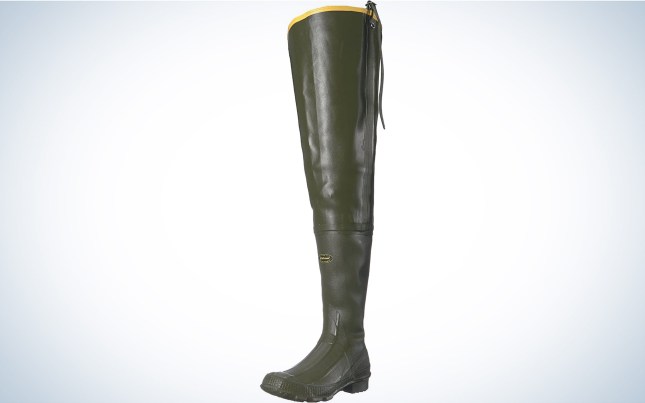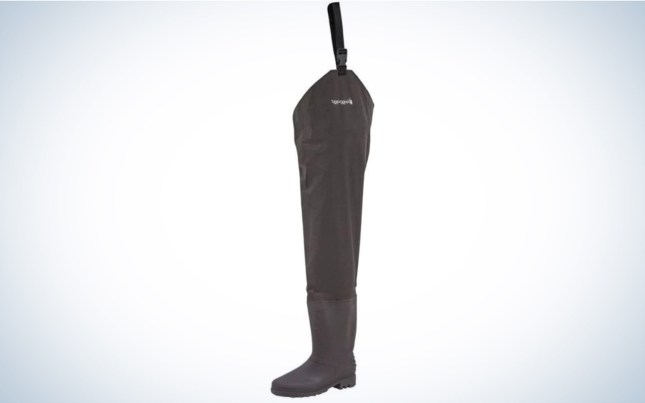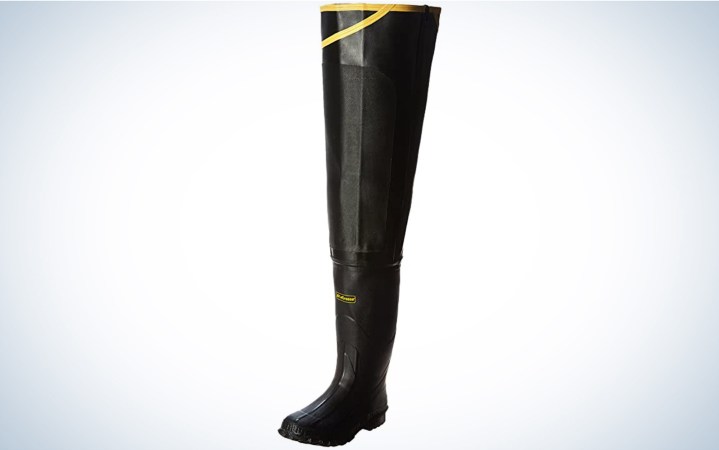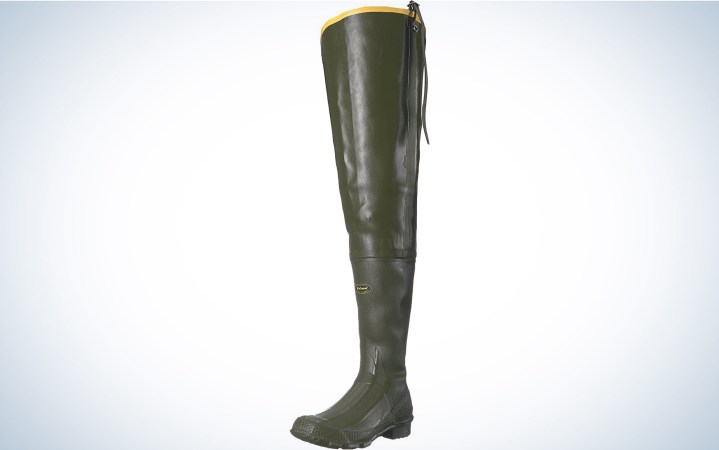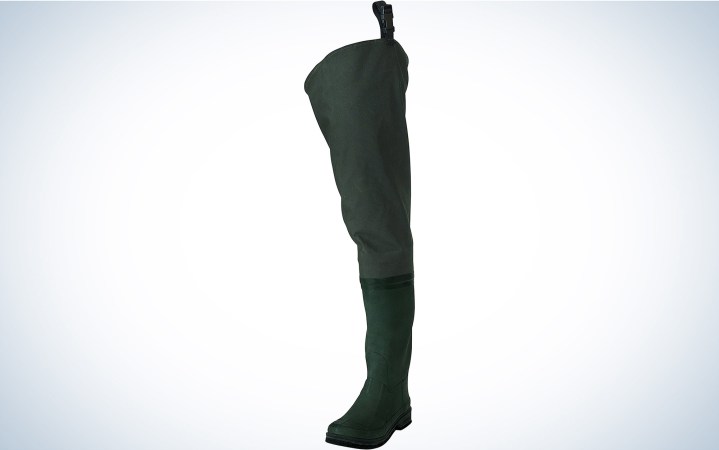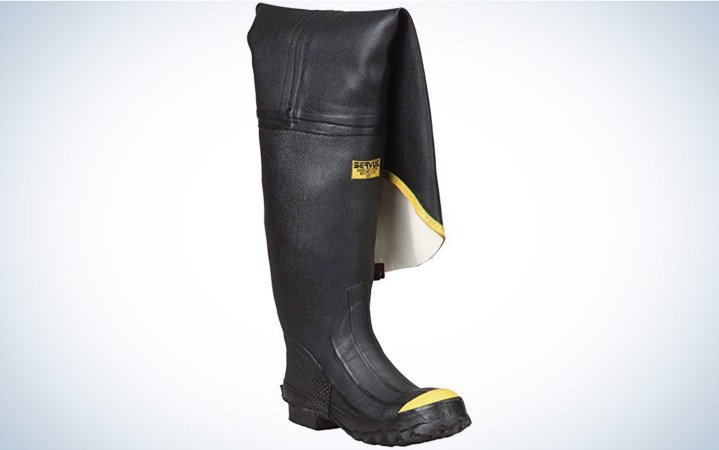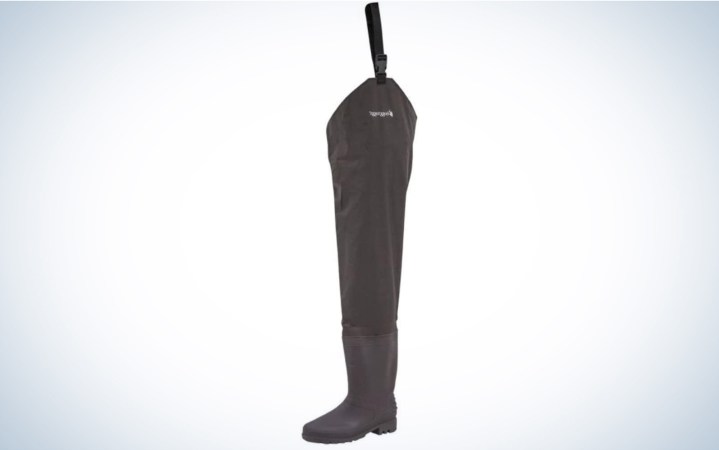We may earn revenue from the products available on this page and participate in affiliate programs. Learn More ›
Hip boots are classic hunting and fishing gear. They keep your legs warm and dry in wet conditions, and aren’t as cumbersome–or as expensive—as waders. If you hunt ducks, wade-fish rivers and streams and ponds, or simply spend a lot of time working in muddy and swampy conditions, then you need the best hip boots in your arsenal.
A hip boot is a cross between a rubber boot and a stocking wader. They keep your legs dry up to just below your crotch. They’re great all-around fishing boots. Obviously, they’re not for use in situations where you need to wade in water that rises about your waist. But they’re easy to get around in, inexpensive, and comfortable.
- Best Overall: Lacrosse Men’s Premium Hip Boot
- Best Insulated: Lacrosse Men’s Big Chief
- Best for Slippery Conditions: Frogg Toggs Cascade Elite Cleated Hip Waders
- Best for Working: Ranger 36″ Heavy-Duty Hip Boots
- Best Budget: Frogg Toggs Men’s Rana Hip Wader
Things To Consider Before Buying the Best Hip Boots
Hip Boots or Waders?
Hip boots are an alternative to another popular piece of outdoor gear: waders. There are three key differences between the two.
The first is that waders (meaning chest waders, the most common type) are naturally higher than hip boots. If you know that you’re going to be wading in water deeper than the top of your knees, you should consider purchasing chest waders.
The second difference is that waders typically come with a “stocking boot” fit, meaning you must buy and put on wading shoes. With hip boots, the boot is seamlessly attached to the upper section.
The third is that hip boots are cheaper than waders. There’s less material, and you don’t need to buy separate wading boots.
Durability
Outdoor gear should always be durable. One of the best aspects of hip boots is that unlike waders, they don’t have many seams that could potentially tear leaks. This means that they should last you a long time—so long as you select a well-made pair.
Hip boots are made out of several types of fabric. The classics are all rubber, which means they’re both durable and fully waterproof, but your mobility might be somewhat limited. The other main option is a combination of both rubber and nylon material. These aren’t typically as durable as rubber, but they should still offer good waterproofing qualities. These hip boots typically run cheaper than full rubber, but buyer beware: These hip boots have a higher chance of springing a leak. If you’ll be wading in rocky areas, walking through thick brush and brambles, or kneeling often, make sure your boots are 100 percent rubber and reinforced at typical wear points.
Warmth
During the hottest days of the year, odds are you are going to “wet wade,” which means you’ll put on some shorts and old sneakers and call it good. Hip boots are generally made for fishing in colder conditions, when you don’t want to get wet.
Some hip boots rely only on their waterproofing qualities to keep you warm, while others are insulated. Deciding if insulated hip boots are the right choice depends on the conditions that you’re most likely to face, as well as your personal temperature tolerance. Insulated hip boots are a good call if you fish, hunt, or work outside when it’s near or below freezing.
Traction
Most hip boots come with either felt or rubber soles. The kind of soles you should purchase depends on personal preference, the type of surfaces you’re going to encounter most often, and the regulations in your area.
Felt provides good traction for anglers in gravely or sandy rivers and lakes. The felt offers great underwater grip on slippery rocks. (Beware: felt soles are banned in some parts of the world because they have the potential to transfer invasive species between different bodies of water.) Rubber soles also provide good grip and do much better in icy winter conditions than felt soles. Waders with cleated soles are ideal if you have to navigate muddy or mucky stream bottoms, or climb up and down riverbanks to get to the water and back. (And see our note below about metal boot studs.
Work
Hip boots aren’t just pieces of fishing and hunting gear. Many people use them for work. They’re an especially good option for people who work outside in damp environments. If you spend a lot of your work day mucking through water or mud or otherwise sloppy conditions, you should get a pair that’s made for the job, with super-thick rubber that will resist punctures and a steel shank for support. A steel toe will protect you if you’re dealing with heavy objects. Also look for good insulation and all-rubber construction.
Budget
High-quality hip boots will last longer and keep you warmer and dryer than budget options. That said, you don’t have to lighten your wallet entirely to get a decent pair. That said, if you’re looking for a budget option, expect to replace your new pair sooner rather than later. But for occasional use, a low-priced pair of hip boots should suffice.
Best Hip Boots: Reviews & Recommendations
Best Overall: Lacrosse Men’s Premium Hip Boot
LaCrosse makes farm, hunting, and work boots known for their longevity and quality, and the LaCrosse Men’s Premium Hip Boot is one of the best hip boots on the market. These are ozone- and abrasion-resistant and feature 100% rubber construction. They’re reinforced at the ankles and the Trac-Lite outsole provides impressive stability.
Best Insulated: LaCrosse Men’s Big Chief
The LaCrosse Men’s Big Chief hip boots are a phenomenal option for hunters and anglers who brave the cold regularly. They’re 100 percent waterproof and offer superior traction with an air-grip outsole. What really sets these boots apart is the 600 grams of Thinsulate Ultra insulation, which will keep your legs toasty even in harsh cold.
Best for Slippery Conditions: Frogg Toggs Cascade Elite Cleated Hip Waders
The Frogg Toggs Cascade Elite Cleated Hip Waders are perfect for anglers who need to wade in slippery muck, or climb up and down streambanks The cleated sole provides added traction compared to non-cleated outsoles. A waterproof three-ply design sandwiches rubber between two nylon jersey layers to make the waders durable, and 200 grams of Thinsulate give the hip boots a nice kick of warmth.
Best for Working: Ranger 36″ Heavy-Duty Hip Boots
Ranger’s 36″ Heavy-Duty Hip Boots are made with industrial strength rubber that is hand-laid and vulcanized at high heat. These boots are strong—very strong. A steel toe provides an important safety feature for many workmen. The heavy-duty TracTread outsole is grippy and stable.
Best Budget: Frogg Toggs Men’s Rana Hip Wader
The Frogg Toggs Men’s Rana Hip Wader is a fantastic budget option. They are especially mobile due to their nylon-reinforced PVC uppers. The uppers are welded to non-insulated PVC boots that are available with felt and cleated soles. These aren’t particularly durable or warm, but if you need hip boots for only occasional use, these will get the job done.
READ NEXT: The Best Fly Fishing Waders for 2023, Tested and Reviewed
FAQs
Felt soles do well underwater, especially on stony and rocky river bottoms, but they struggle in icy and muddy conditions. Cleated rubber boots aren’t good on especially slick surfaces, but they excel in mud and mucky stream bottoms.
Rubber is the best material for hip boots. Some hip boots have nylon uppers, which work fine but are somewhat prone to ripping. Thin rubber can rip on sharp sticks and stones as well.
Hip boots should fit like normal rubber boots. You don’t want to slide around in the boots and get blisters. Look for a snug, comfortable fit, with plenty of room for your toes to flex. Take the type of socks you’ll be wearing into consideration, too. Also pay attention to the height specifications of the hip boots you’re considering purchasing, which are usually given in inches. Make sure they extend well above your knees.
Why Trust Outdoor Life?
Since 1898, OL has been a leading authority in testing and reviewing hunting gear, fishing tackle, guns and shooting equipment, and much more. We have more than a century-long history of evaluating products, and we’re now bringing that expertise to online reviews. Our editors are experienced outdoorsmen and women, and most importantly, we’re trained journalists. We prioritize field testing and objective data when reviewing products. We conduct interviews with gear manufacturers and engineers as well as outdoor experts so that our readers have an understanding of how and why a product works—or doesn’t.
Advertising does not influence our gear reviews and it never will. While we always focus our coverage on standout products—because we want our readers to be aware of the latest and greatest gear—we also cover the flaws and quirks of any given product.
Final Thoughts
Need additional traction on the best hip boots? Get metal boot studs. If you’ll be wading in creeks with moss- or slime-covered rocks, or climbing onto jetties, invest in a set of metal boot studs. These screw into the soles of your boots and provide superb traction.
- Best Overall: Lacrosse Men’s Premium Hip Boot
- Best Insulated: Lacrosse Men’s Big Chief
- Best for Slippery Conditions: Frogg Toggs Cascade Elite Cleated Hip Waders
- Best for Working: Ranger 36″ Heavy-Duty Hip Boots
- Best Budget: Frogg Toggs Men’s Rana Hip Wader
